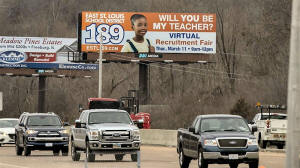Regional superintendents look to address Illinois teacher shortage
 Send a link to a friend
Send a link to a friend
[May 19, 2021]
By RAYMON TRONCOSO
Capitol News Illinois
rtroncoso@capitolnewsillinois.com
 SPRINGFIELD – Following a February survey
of school districts that illustrated a persistent teacher shortage in
the state, the Illinois Association of Regional Superintendents of
Schools has released policy recommendations calling for better benefits
and more lenient certification in an effort to reverse the trend. SPRINGFIELD – Following a February survey
of school districts that illustrated a persistent teacher shortage in
the state, the Illinois Association of Regional Superintendents of
Schools has released policy recommendations calling for better benefits
and more lenient certification in an effort to reverse the trend.
The IARSS, which serves as an intermediary between local school
districts and the Illinois State Board of Education, had the survey
conducted between September and October to see how school districts were
faring with the supply of professional and substitute teachers during
the 2020-2021 school year amid the coronavirus pandemic.
Illinois was split into seven regions for the purpose of the survey, and
school districts reported the shortage was worst in west central and
southeastern Illinois.
White papers developed in response to the survey give seven policy
recommendations as ways to combat it from the local to statewide level.
The two primary methods discussed in the white paper are improving
teacher pay and lessening the restrictions on certifications teachers
need in order to get hired.

Compensation
When it comes to compensation, it’s not as simple as just increasing
teachers’ salaries, according to IARSS President Mark Klaisner.
“One of the misnomers has been that you can just throw money at salary,”
Klaisner said in an interview with Capitol News Illinois.
It was just two years ago that Illinois passed a law raising teacher
pay, with a mandated minimum of $40,000 by the 2023 school year.
Representatives of the IARSS filed witness slips in opposition to the
minimum wage increase during committee hearings on the matter in 2019.
While Klaisner said that action was taken in an effort to address the
teacher shortage, he believes it actually had the opposite effect in
many places, particularly in the rural, less affluent regions of the
state.
“Unfortunately, small school districts were reporting to me, that didn't
solve a problem it caused a problem, because if I have to pay a minimum
of ($40,000), I'm going to let a couple teachers go so I have money to
meet the 40 threshold,” Klaisner said. “Now my class sizes go up, so
education's not better. All I've done is I've moved a problem from one
column to the other column.”
According to Klaisner, without additional funding, schools in rural
areas have to make the difficult choice between offering a lower
relative salary – which makes them less competitive than their metro
counterparts – and cutting some positions to add the difference to core
positions to attract applicants.
The National Education Association lists the state’s average teacher
salary at $68,000, and the average starting salary at $40,484. But in
the most rural and underserved areas of the state, particularly in the
west central and southeastern regions, open positions offer the state’s
bare minimum, which is increasing from $32,000 in the current school
year to just under $35,000 for the 2021-2022 school year starting in
August.
“We know there’s certain sectors of the state that’s suffering more than
others,” John Meixner, a regional superintendent who oversees Fulton,
Hancock, McDonough and Schuyler counties said in a podcast on education.
“A normal teaching position opens up and an applicant pool up in (Cook
County) may have, instead of 150 applicants you might only have 20,
whereas instead of having 10 we have zero,” he added. “I mean literally
we've had positions, dozens of positions where zero applicants apply.”

Longstanding problems with the Teachers Retirement System – the pension
plan for all Illinois public school teachers outside of the Chicago
Public Schools district – have also served as a barrier to attracting
applicants to the profession.
The Tier II retirement system available to those hired after 2010
requires teachers work until they are 67 years old to receive full
benefits. It also provides less compensation in retirement as their
contribution to the plan also works to pay down the unfunded liability
of teachers enrolled in the previous pension plan.
On the salary front, IARSS is recommending school districts lobby the
state to approve state-funded loan forgiveness programs for teachers who
take jobs in underserved areas, as well as experiment with signing
bonuses to attract new applicants.
The IARSS also recommends amending the pension plan to allow teachers to
retire at 55 years of age for reduced rates.
Certification
Currently, becoming a teacher in Illinois requires a Professional
Educator License. To receive one, a prospective teacher requires at
least a bachelor’s degree, student teaching experience, the completion
of a state-approved teaching program and a licensing test.
Licensing tests are split into several grade levels, and teachers
certified in one grade level are not considered suitable for hire under
a different grade level unless they successfully pass a license exam for
that as well.
An educator certified for early childhood can hold a position teaching
from birth to grade 2, while an elementary certified educator can teach
from grade 1 to 6, and a middle grades educator from grades 5 to 8.
During the pandemic, ISBE, in conjunction with the Illinois Community
College Board and Illinois Board of Higher Education, granted
endorsement waivers as part of Gov. JB Pritzker’s emergency order to
allow schools to fill positions with teachers certified for grade levels
or subjects other than the ones they were hired to teach.
[to top of second column]
|

A billboard located along Illinois State route 15 in
Centreville, Illlinois advertises for teachers for East St. Louis
School District 189. (Credit: Belleville News-Democrat)

IARSS recommends continuing this practice as a
temporary measure as well as auditing whether current licensing
restrictions are unnecessary or have exacerbated shortages.
For endorsement areas with a high rate of unfilled positions, such
as special education, mathematics and school psychologists, IARSS
has recommended ISBE look at increasing funding for higher education
programs offering certificates in those fields, as well as creating
pipelines to transition students from rural school districts to
nearby colleges to become teachers in short-staffed positions.
Education budget
After initially keeping funding for K-12 education flat at about
$8.8 billion for the fiscal year in his initial February budget
proposal for the 2022 fiscal year, Pritzker reversed course earlier
this month and announced he was calling for $350 million to be added
to the budget for education.
That’s in line with the evidence-based school funding model of 2017,
which calls for that amount of money to be added to the formula each
year.
Education advocates, including bipartisan members of the General
Assembly, have strongly praised the evidence-based funding model,
which allocates state dollars to districts according to the gap
between them and what the state considers to be a required level of
adequacy. Each district’s adequacy target is determined by a school
district’s ability to fund proper staffing, student resources and
moderate class sizes, among other factors.
Klaisner suggested the state should use that evidence-based formula
to distribute federal COVID-19 stimulus dollars, including around $5
billion for education received as part of the American Rescue Plan
signed by President Joe Biden. Pritzker, as well as the U.S.
Department of Education, has placed parameters on how funding should
be spent, and both have strongly discouraged using the stimulus
money to pay salaries.

So far, school districts have used the stimulus money they have
received in ways as varied as the school districts themselves.
According to Klaisner, one school district used what he called
“flash in the pan money” – one time funds that should be used for
one-time expenditures and not long-term costs like teacher salary –
to replace its decade-old fleet of buses.
In Collinsville, a city of under 30,000 located in the Metro East
region near St. Louis, the school district used $300,000 in stimulus
funds to construct a broadband tower, creating a private network to
provide high-speed internet access to underserved students and their
families throughout the school district.
Ongoing inequities
While an analysis shows the teacher shortage has actually improved
over the last four years, particularly in suburban and urban parts
of the state, there continues to be a great disparity in the
availability of teachers between rural and metropolitan regions.
A post-survey analysis by the IARSS shows geographic location was
the number one factor negatively impacting recruitment, ahead of
salary and pension. Over 50 percent of school districts said their
geographic location had a negative impact.
In 2019, Cook County and surrounding collar counties had 240
unfilled or underfilled positions, while that number was 228 for the
west central region. By 2020, Cook County had reduced that figure to
just 91, while the west central region had 257 unfilled positions.
The disparities also exist along racial lines. When controlling for
the size of the district, the IARSS analysis found that the racial
makeup of the student body – even more than location – was the
number one predictor of whether positions in that district would be
underfilled or have below-average retention rates for staff.
The higher the proportion of white students a school district had,
the fewer underfilled positions.
The analysis also concluded that there was no association between
vacancies and the proportion of low-income students, and that racial
demographics were also a greater factor than the proportion of
English-learning or English-as-a-second-language students.
Klaisner noted that research shows students who belong to an ethnic
or racial minority benefit when at least one of their instructors
belong to the same racial or ethnic group as them.
“We see all over the state, the demographics are very clear that
oftentimes our staffs don't represent the students that they serve,
and we feel like that would be a value add, if not essential,” he
said, pointing to policies like minority teacher grants and ISBE
initiatives to recruit teachers of color.
Despite this, the IARSS white paper concluded the most important
predictors of success when it came to hiring and retaining staff was
educator pay and how close the school district was to a teacher
preparation program. Stakeholders should focus on addressing these
factors, according to the analysis.
“While districts may not be able to change their geography or
student demographics, they do have some control over teacher
salaries, and institutions of higher education have some role to
play in working to serve the state’s ‘higher education deserts,’”
the IARSS said in their report.
Capitol News Illinois is a nonprofit, nonpartisan
news service covering state government and distributed to more than
400 newspapers statewide. It is funded primarily by the Illinois
Press Foundation and the Robert R. McCormick Foundation. |